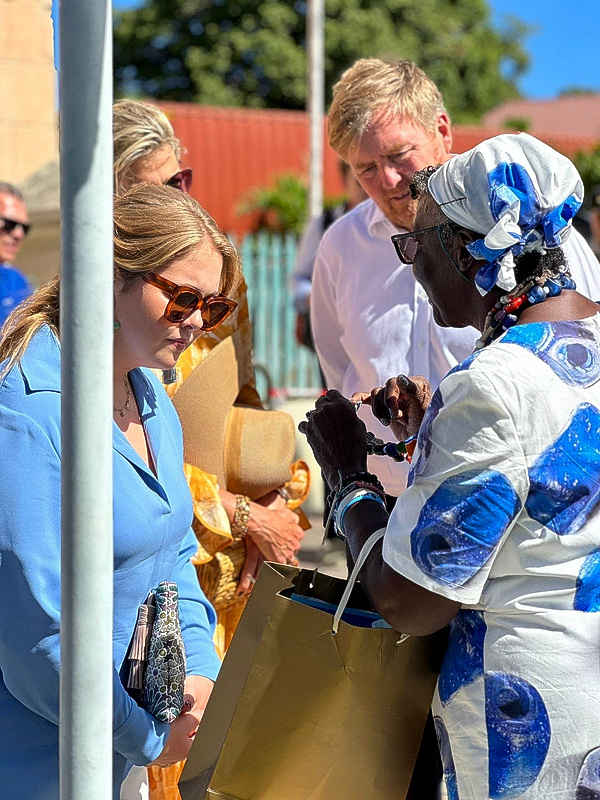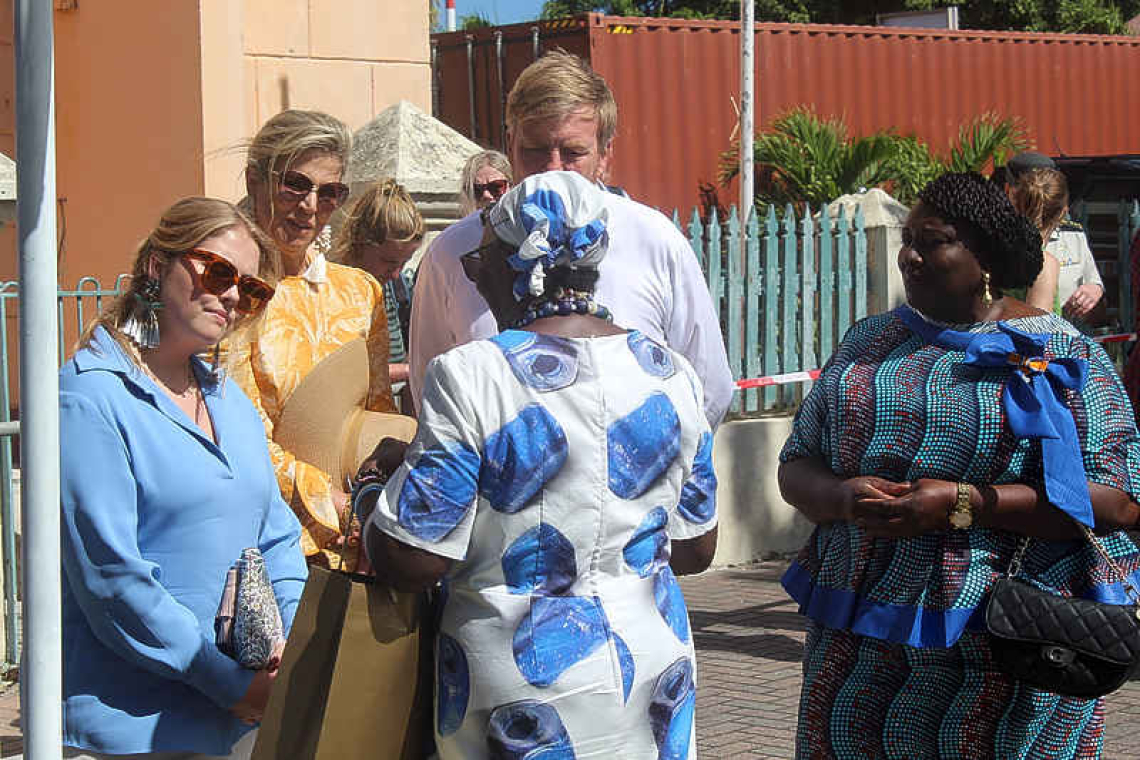From left: Princess Catharina-Amalia, Queen Máxima and King Willem-Alexander listen as Althea Merkman tells the story of the Statia blue beads and Government Commissioner Alida Francis looks on. (Althea Merkman photos)
ST. EUSTATIUS--Princess Catharina-Amalia, Queen Máxima and King Willem-Alexander were given a presentation on the Statia blue bead during their visit to St. Eustatius on Wednesday.
Althea Merkman spoke about the beloved blue bead, giving a degree of reverence for this special piece of coloured glass. There was an infectious joy in her tone and unequivocal awe in her inspired words.
To Merkman and generations of Statians, there is something magical, mystical and mythical about the Statia blue bead.
“When you’re looking for the bead, you don’t find any beads; it’s when you’re not looking, the bead finds you,” said Merkman, correspondent and photographer of The Daily Herald newspaper, who has been collecting and sharing the unique blue beads for much longer than she can remember. She still wears on her necklace the first one she found decades ago when she was still a child. And she takes pride in helping other people create their own bead legend.
As much of an authority on the Statian gem as any, Merkman was chosen to tell the story of the Statia blue bead to the visiting royal family. When she greeted the royal family, she sang the tune “The Royal is Here and How Are We, We Welcome You in Warmly to Statia History”.
In her early days of bead-hunting Merkman found them rather easily, particularly on the beach and in the ruins. But they are a lot more difficult to come by these days, although she continues to have the knack of finding them – unlike everyone else who must wait for the beads to find them.
Merkman spoke about the Blue African spun beads; these beads were vastly produced to balance out the demand for beads during the slave trade. The beads were produced so fast that even the quality was less than that of the Dutch and Venetian beads being used.
As the demand rose, materials became poorer, so everyone produced these beads as a form of trade. But it quickly died out due to the demand for the specific Dutch five-sided beads so popular amongst traders.
A blue bead was presented to Princess Catharina-Amalia by Government Commissioner Alida Francis.
“When somebody comes to the island, if the bead finds you while you are here it means you will always return to the island,” Merkman said in a reverential tone that she maintained throughout, followed by a hearty laugh. “And some people always do.”
The story of the Statia blue bead is linked to the island’s encounter with slavery. The first enslaved Africans were brought to Statia nearly 370 years ago, in the mid-1600s. They were imported to work on the plantations where sisal, indigo, cotton, tobacco, and sugar were cultivated for sale. By the mid-1700s the island had become a major trading centre, including a key hub for trading enslaved people in the northern Caribbean.

From left: Princess Catharina-Amalia, Queen Máxima and King Willem-Alexander listen as Althea Merkman shows and explains about some of the blue beads she has found and received over several decades.
Said to have been commissioned from Venetian glass blowers by Dutch traders – and also made in factories in the Netherlands – the beads were used as currency to “reward” the enslaved for their work, according to historians. They in turn used beads among themselves to “pay” for goods and services secured from each other. In addition, for a slave to receive permission from the Dutch to get married, he had to “earn” enough beads to be strung around his future wife’s waist.
The European slave traders also used the beads to purchase slaves in Africa and, because Statia served as a major trading centre, large quantities of blue beads were transported to the island in the 17th and 18th centuries and stored in warehouses across Statia, so the slave owners and traders sailing to Africa had a ready supply.
However, with the abolition of slavery on July 1, 1863, the blue beads were no longer of value to the slavers, who simply left them on the islands. Legend also has it that when the enslaved were finally emancipated they threw the beads over the cliffs and into the sea.
These relics remain, 160 years later, an important link between those dark days of the past and a promising future for the residents of this 8.1-square-mile island. And their impact on those who find them – or, more fittingly, those whom they have found – is profound.
“I’ve seen persons, when they find a bead, you’ll think that something is wrong with them. Some of them you see them jumping and screaming and shouting. It happened to a niece of mine. One Sunday we went to look for beads and then all of a sudden I heard the child screaming and jumping. So, I got scared, wondering what was wrong with her. And then she started saying, ‘I find a bead, I find a bead,’” Merkman revealed with a smile as large as the Caribbean Sea.
“I met a lady just this week and she said about 25 or 27 years ago I took her on a blue bead hunt, I don’t recall that, but she does. She didn’t find any on that day, but she found it later after I explained to her how to go about looking for them.”
Due to the movement of the slave traders, glass beads can still be found on other Caribbean islands. But, according to curators, museum workers and collectors, the five-sided beads are unique to Statia.
“Those five-corner beads were made in Holland, especially for Statia, and they are the ones you find here, you don’t find them anywhere else. You’ll find other beads, but not these types,” said Merkman. “The material came from Africa and the beads were made in Holland.”







